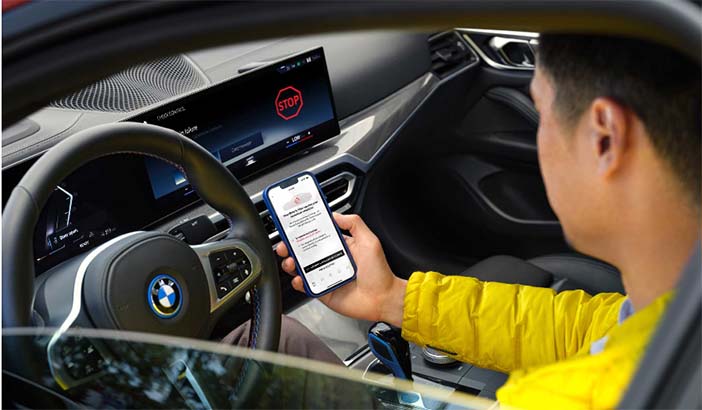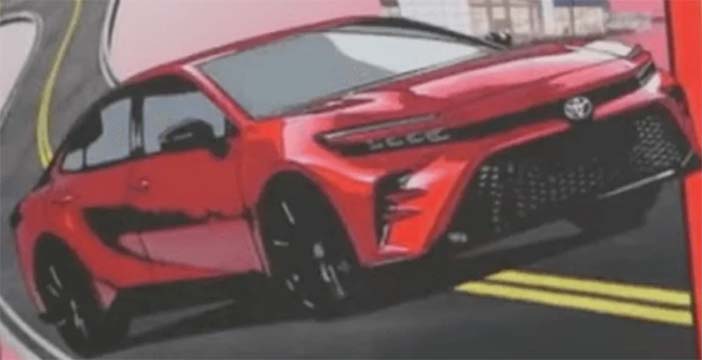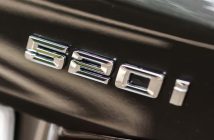+++ The BMW Group is unveiling a new data- and AI-driven offering in customer service. Proactive Care includes new tools and offerings that allow the vehicle to identify existing and predictable service requirements itself, so that in many cases it can anticipate the customer’s needs and proactively offer solutions. The first applications for existing and upcoming vehicle generations are live. These will be continuously enhanced with further innovative functionalities in the coming years. BMW vehicles have already been sending service-related data directly from the vehicle to the BMW dealer following confirmation by the customer for several years, and in this way enabling targeted interaction between customers and BMW dealers. Up to now, it was still the customer who had to approach their BMW partner themselves. Now BMW is proactively approaching the customer. The dealer service requirements contained in the portfolio are constantly being extended and, where it makes sense, augmented with the benefits provided by the broad field of artificial intelligence. The result in the next stage of evolution in the area of connected vehicles and customer service. Digital tire diagnosis, fault messages in the vehicle, service requirements; custom proposals for solutions are made possible by data analyses and the recording of customer preferences. The digital-first approach applies here: depending on what is needed, the customer is notified via a message in the My BMW app, via an in-car notification, via e-mail, by their preferred dealer or by a telephone call from Roadside Assistance. Proactive Care improves the customer’s service experience in the long term; from self-help tips (e.g. how to solve a problem via a Remote Software Upgrade) to flexible support in order to guarantee mobility or by suggesting the right dealer in the global dealer network if a visit to the workshop cannot be avoided. Online appointment scheduling and a personalized service video including online payment handling are just some of the possible options. Proactive Care is available worldwide for all BMW models with BMW Operating System 7 or later (as of version 07/2019). All customers need is an active BMW ConnectedDrive contract and to register their vehicle in the My BMW app or in the My BMW portal with their BMW ID and store their contact details. In order for data collection to be possible, the customer must accept the Privacy Policy in the vehicle, enable push notifications in the My BMW app and consent to be contacted by BMW AG or their BMW Service Partner. The scope of the work carried out, the costs for this work and when the vehicle should be ready for collection are available to the customer in a transparent manner at all times. The BMW Group attaches great importance to the confidentiality and integrity of personal data. Data protection and data security have the highest priority for the BMW Group. BMW has committed itself to the collection of data for specific purposes. This means that data is collected intelligently only for dedicated services. The BMW Group adheres to the current legal situation as per the General Data Protection Regulation of the European Union and complementary national laws, such as the German Federal Data Protection Act. This also applies to the use of systems installed in the vehicle. With Proactive Care, BMW is offering a completely new service experience for its customers, and placing customer satisfaction even more firmly at the center of what it does. +++

+++ The European Union (EU) is set to demand that cars running on e-fuels must be 100% carbon neutral if they are to be sold beyond 2035, a draft document showed, after Germany demanded e-fuel cars be exempted from the phase-out of new polluting vehicles. All new cars sold in the EU from 2035 must have zero CO2 emissions, under the EU’s main climate policy for cars, which countries agreed earlier this year. However, the European Commission is developing a legal route for sales of new cars that only run on E-FUELS to continue after 2035, after Germany demanded this exemption. A draft EU legal proposal showed Brussels plans to set strict conditions for e-fuel cars, requiring them to run on fully CO2 neutral fuels. E-fuels are considered carbon neutral when they are made using captured CO2 emissions that balance out the CO2 released when the fuel is combusted in an engine. The draft rules would be stricter than the low-carbon fuel rules in some other EU climate policies. For example, countries can use certain fuels to meet EU renewable energy targets if they achieve a 70% emissions saving, rather than 100%. “Especially when it comes to reducing CO2 emissions of the existing fleet, which already comprises around 250 million vehicles in Europe today, climate-neutral fuels can play an important role in decarbonising transport”, BMW said in a statement. “This is why all BMW engines are already approved for e-fuels, provided they comply with the current fuel standard”. The eFuel Alliance industry group said the draft proposal would effectively ban new combustion engines from 2035, if it counted emissions along the value chain as well as those from producing an e-fuel. “A 100% reduction in emissions is therefore nearly impossible”, Ralf Diemer, the group’s managing director, said in a statement. The draft rules would form a legal basis for carmakers to register a new type of vehicle – a combustion engine car that runs exclusively on carbon neutral fuels. Such vehicles must be designed so that the engine would not start if the vehicle is fueled with CO2-emitting petrol, under the draft rules, which could change before they are due to be published later this year. Manufacturers would need to enforce this using technologies such as devices that track the chemical properties of the fuel. They would also need to develop rules to make sure these technologies cannot be tampered with, the document said. +++
+++ FORD said Monday that it’s pausing construction of a $3.5 billion electric vehicle battery plant in Michigan until it is confident it can run the factory competitively. The move comes as the company is in the midst of national contract talks with the United Auto Workers union, which wants to represent workers at battery factories and win them top wages. The UAW went on strike against Ford and the other 2 Detroit automakers, General Motors and Stellantis. The union at first targeted one vehicle assembly plant from each automaker, and last week expanded it to parts warehouses. But Ford was spared from the expansion because the union said progress was being made in negotiations. In February, Ford announced plans to build the plant in Marshall, Michigan, employing about 2.500 workers to make lower-cost batteries for a variety of new and existing vehicles. Marshall is about 160 kilometers west of Detroit and is near 2 major interstate highways. But Ford spokesman TR Reid confirmed Monday that plant construction has been paused and spending has been limited on it. “There are a number of considerations”, he said. “We haven’t made any final decision about the planned investment there”. There also has been local opposition to the factory location and criticism of a Chinese company’s involvement in the plant, which would be run by a wholly owned subsidiary of Ford. The factory was to start making batteries in 2026, cranking out enough battery cells to supply 400.000 vehicles per year, Ford said. It would produce batteries with a lithium-iron-phosphate (LFP) chemistry, which is cheaper than the current nickel-cobalt-manganese chemistry now used in many EV batteries. Consumers could then choose between a battery with lower range and cost, or pay more for higher range and power. Ford said the subsidiary would own the factory and employ the workers. But China’s CATL, which is known for its lithium-iron-phosphate expertise, would supply technology, some equipment and workers. Republican state representative Sarah Lightner, whose district includes Marshall, said Monday the news from Ford “came out of the blue”. “We’re still gathering information because there’s a lot of moving parts”, Lightner said. While the state had allocated nearly $1.7 billion in incentives for the project, not all of the money has been sent out and there are clawbacks in place, added Lightner, who is the minority vice chair of the House Appropriations committee. “Obviously, the strikes could probably have something to do with it”, Lightner said. Sam Abuelsamid, an analyst with Guidehouse Insights, said Ford’s decision might be related to the strike but more likely reflects opposition to the plant among people in a conservative rural area of southern Michigan. “They don’t want the factory, they don’t want the traffic and they don’t want anything associated with a Chinese company”, he said. Abuelsamid said he was surprised that Ford didn’t select a site closer to Detroit, which he thinks would be less hostile to the idea of a battery plant using a Chinese company’s intellectual property. The plant was announced at a time when U.S.-China relations are strained, and the Biden administration is offering tax credits for businesses to create a U.S. supply chain for EV batteries. To get a full $7.500 per vehicle U.S. tax credit to customers, EV batteries won’t be able to have metals or components from China in them. The structure of the deal allows Ford to take advantage of U.S. factory tax credits in the Inflation Reduction Act. Earlier this year the state of Virginia dropped out of the race for the same Ford plant after governor Glenn Youngkin characterized the project as a “front” for the Chinese Communist Party that would raise national security concerns. At the time Virginia had not offered an incentive package to Ford. +++
+++ LOTUS today has announced the business has further expanded across Europe in Denmark, Austria and Luxemburg. Customers will soon be able to purchase a Lotus vehicle from selected retailers in these markets. With the addition of the 3 new countries added today, Lotus is now represented in 13 markets across Europe. Next to the United Kingdom and Ireland, those also include Belgium, France, Germany, Italy, Netherlands, Norway, Sweden and Switzerland. Europe is a key market for Lotus, where the company has accelerated its growth over the last year. Lotus has opened several new Lotus branches and brand centers in the region. As of 30 June 2023, Lotus had 67 existing stores across Europe and plans to open 105 stores across Europe by 2025. Niels de Gruijter, executive director of Lotus Cars Europe, said: “We are delighted to bring the thrill of owning a Lotus to customers in Denmark, Austria and Luxembourg. From our sportscar Emira, to our electric hyper-SUV Eletre and our recently launched electric hyper-GT Emeya, we have a growing product portfolio that appeals to a broad audience. I can’t wait to see our cars on roads in these countries”. Lotus has continued to see an increasing demand for its products, with an orderbook of over 17.000 for its Emira sports car and Eletre hyper-SUV. The orderbook for Emira is full for the next 2 years. The company has ramped up production this year, having had a record-breaking first half of 2023, and expects the full year to surpass all previous sales years. +++
+++ RENAULT is pushing ahead with plans for an electric rebirth of its iconic 5 and 4 models, but the company isn’t about to forget its regular supermini, the Clio. Work has started on a new generation of the popular model, complete with petrol-based powertrains. The supermini market has been shaken up dramatically in recent months, not least by the disappearance of the Ford Fiesta, one of the Clio’s traditional rivals. Renault itself has switched the facelifted version of its current offering to hybrid power in several key markets and in the longer term the brand has committed to introduce only pure-electric vehicles from 2030 onwards. However, the company’s Chief Technology Officer, Gilles Le Borgne, stated firmly that in the meantime, the Clio has a future beyond its current generation and will be sold alongside the reborn 5 and 4. “We are working, as we speak, on the next generation of Clio”, Le Borgne said. “And that car will have some ICE engines because it will be on sale before 2030”. Renault is likely to build on the current Clio’s technical make-up for a new version, which is set for a reveal in 2026. It will adopt some of Renault’s latest combustion-engined styling cues, as introduced on the Rafale. Inside, the next generation is expected to get upgraded materials, as well as a switch to the same Android Automotive-based infotainment system that is used on the Mégane and Scénic. It’s conceivable that at some point in the next Clio’s life the TCe and Hybrid versions could be joined by an all-electric version that offers greater practicality than the 3.7 metre-long reborn R5. Le Borgne stopped short of confirming that the Clio could adopt this twin-track approach on powertrains, but he acknowledged that the car’s CMF-B platform and the CMF-BEV architecture used by the 5 are linked closely enough to make such a move technically feasible. “You can have the same top hat, with BEV underneath or ICE underneath”, he said. “The general architecture, with the R5 and R4, is dedicated pure electric, but the hard points, from an industrial design point of view, can be cut to make a combustion-engined car, too”. Renault has also gone through a huge cost-cutting program to make CMF-BEV more financially viable; at least some of these modifications are expected to be fed back across to CMF-B to help boost the profitability of ICE variants. The powertrains offered on the next Clio could well be developed by a new company formed by Renault and Chinese giant Geely. The 2 firms’ engine divisions have combined to incorporate 17 existing factories, 5 development facilities and more than 19.000 staff. The new company will be tasked with producing even more efficient petrol-hybrid systems, potentially for sale beyond the Renault-Nissan-Mitsubishi Alliance. Renault Group CEO Luca de Meo believes that splitting the division off makes it more answerable to market forces on cost, as well as opening up greater economies of scale. +++
+++ Volkswagen’s decision to stop offering the Golf GTI and the Golf R with a manual transmission seemingly came at the wrong time. While STICK-SHIFTS still make up a small percentage of new-car sales, a recent study finds that demand for the manual transmission is increasing. Stick-shifted models represent 1.7% of new-car sales in the United States in 2023 so far. For context, 1.2% of the cars sold new in 2022 came with 3 pedals and that figure stood at 0.9% in 2021. It’s not just new cars, either. CarMax, which sold 807.823 used cars during the 2023 fiscal year, said that sales of stick-shifted cars have increased from 2.4% in 2020 to 2.9% in 2022. Surprisingly, the retailer added that buyers in their 20s played significant role in pushing that figure towards the 3% mark. “Customers have expressed interest in manual-transmission vehicles due to a variety of factors, including nostalgia and throwback culture”, Mark Collier, a regional vice president and general manager at CarMax. Less surprisingly, many of the motorists who take home a manual car choose it for the fun factor, not to save money. The days of ordering a stick to spend less are nearly over because a lot of relatively cheap new cars, like the Kia Rio, come standard with two pedals. Carmakers increasingly market the manual transmission as the enthusiast’s choice. CarMax’s best-selling manuals are the Honda Civic, the Ford Mustang, the Subaru WRX, the Jeep Wrangler, the Chevrolet Camaro, the Ford Focus and the Dodge Challenger, according to the report. For others, the stick remains a practical choice. “We’ve also heard from parents, who are car-shopping for their teens, that they find stick-shifts appealing because they require the use of both hands, which may serve as a deterrent for texting while driving”, Collier concluded. +++
+++ TOYOTA may have given the world an unintended sneak peek at an updated Camry. The illustration of a red sedan with a brand new face appears partway through an innocuous video about buying versus leasing. The video has since been taken down. The drawing adorns the cover of a book in the video titled called “The Amazing Toyota”. It wears C-shaped headlights that connect to the grille in one graphic spanning the front of the car, similar to the sexy new Prius. It resembles other recent Toyota designs, like the Crown Sport unveiled in 2022. However, that Crown Sport is a half-wagon, half-SUV, and the body of the car in the video is distinctly a sedan, much lower to the ground. The rest of the leaked illustration shows door cut lines and a greenhouse that look identical to the current Camry’s. It also has the surfacing of the rear quarter panel that forms a small flare over the rear wheel arch. The 2024 model year Camry is carried over with minimal changes, going on its 7th year. It’s due for an update, but the car in the image doesn’t look like a full generational redesign. It’ll likely be another facelift with minor hardware tweaks, and we’re all for a cleaner style than the busy nose of the current Camry. Perhaps the large black wheels and aggressive air intake hint at a sporty version like a TRD, or even the rumored performance-spec GR Camry. The Camry is currently the only traditional sedan in the top 10 lest of best-selling cars of 2023 so far, and still an important model for the Big T. However, with other companies rumored to be killing off their staple sedans, we can’t blame Toyota for not investing in an all-new generation. The sedan market continues to shrink as crossovers take over. +++



